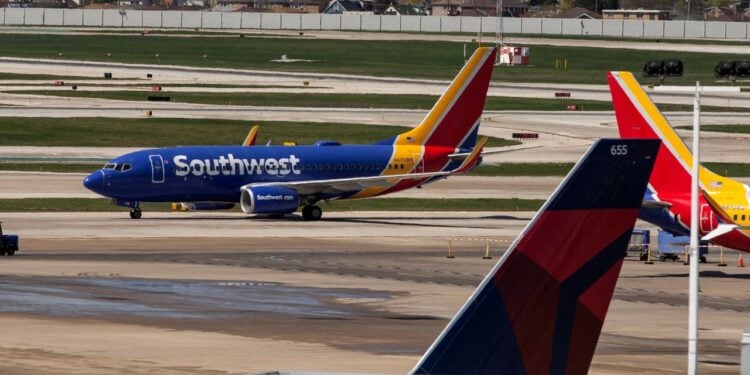Southwest Airlines’ first company-wide layoffs in its nearly 54-year history are aimed at shoring up profits, but they run the risk of undermining a company culture of putting employees first that made it stand out from rivals and cultivated a loyal fan base.
Until this week, the U.S. carrier never resorted to mass layoffs and furloughs, even as the industry underwent crushing downturns. But soaring costs and sagging profits forced its hand on Monday to announce that it will slash 1,750 jobs, or 15% of its corporate workforce.
Conor Cunningham, an analyst at Melius, said the layoffs go against the company’s long-built culture, which he described as “the special sauce that makes everything possible.”
The layoffs also reflect a new reality at Southwest, where activist investor Elliott Investment Management’s nominees currently hold five of 15 board seats and CEO Bob Jordan is under pressure to produce a fast turnaround.
At meetings with Southwest’s unions last year, Elliott had emphasized the need to “right-size” the company’s headquarters, according to a person who attended the meeting.
Jordan has outlined a strategy that seeks to lift Southwest’s operating margin to at least 10% in 2027 from 2% last year.
Robert Mann, a former airline executive who now runs a consulting firm, said the job cuts suggest there is a greater urgency to deliver on those goals.
“It’s a nod to the pressure that they’re under from Elliott,” Mann said.
Elliott declined to comment.
Southwest said while the layoff decision was “extremely difficult,” it has tried to provide support and care to the affected employees.
“The strength of Southwest’s culture is critical to the success of our business and our ability to serve our customers,” the airline said in a statement. “Our people will continue to be what sets us apart as we drive the company forward.”
Activist Investor’s Growing Influence
Southwest boasted 47 consecutive years of profit before the pandemic. But planemaker Boeing’s aircraft delivery delays, soaring labor costs and changed travel patterns after the COVID-19 pandemic have all combined to depress earnings.
Lackluster profits coupled with falling shares brought Elliott to Southwest’s doorstep last year. The hedge fund launched a bitter boardroom battle, calling for new leadership and wholesale changes to its business.
A truce last October allowed Jordan to keep his job. But the “cooperation” agreement between Southwest and Elliott is due to end next year.
Other developments also point to the activist investor’s growing influence. On Wednesday, Southwest said its agreement with Elliott has been amended to allow the hedge fund to increase its maximum allowable stake to 19.9% from the previous limit of 14.9%.
The company also said Chief Transformation Officer Ryan Green, who was entrusted with rolling out the turnaround plan, will step down on April 1. His exit follows the departures of Chief Financial Officer Tammy Romo and Chief Administration Officer Linda Rutherford.
“Monumental Shift”
Since 1971 when the airline started operations, it has operated with a philosophy that happier employees result in happier customers. It avoided layoffs even after the 9/11 attacks in 2001 and during the pandemic, which brought the airline industry to its knees and led to mass job cuts.
In the past, the company relied on early retirements and natural attrition to deal with overstaffing. Southwest’s headcount declined by over 2,300 to 72,450 employees in 2024 through natural attrition.
Doug Parker, former CEO of rival American Airlines, last year said Southwest enjoyed a competitive advantage with airline customers because of its culture. He warned that changes to the company’s culture would be bad for its shareholders.
Jordan has called Monday’s announcement a “monumental shift.” In a staff memo on Wednesday, he cited it as an example of how the company must change to maintain its competitive advantage.
Southwest’s cost focus underpinned its success before the pandemic. But the company spent 99% of its revenue on operating costs last year, up from about 80% in 2015.
Its non-fuel operating costs are estimated to increase as much as 9% in the current quarter from a year ago after an annual 11% jump in the December quarter due to rising wages, airport and health insurance charges.
The company has set a target to generate over $500 million in annual cost savings by 2027. Last month, Southwest told investors it was looking to hit that goal “as quickly as possible” and signaled plans to target its corporate overhead.
Its corporate headcount has increased 28% since 2019, faster than the 19% growth in the airline’s total headcount. In comparison, its fleet and seat capacity increased by 7% and 13%, respectively.
Employees on Edge
Southwest said the workforce reduction would save it $210 million this year and $300 million next year.
The layoffs do not affect frontline workers such as pilots and flight attendants. But in a note to members, the head of Southwest’s flight attendant union said the news had created uncertainty for all.
One of Southwest’s pilots called it the beginning of the end of the company’s famed culture.
Several employees took to social media, seeking help for their colleagues.
Aaron Boland, a Southwest employee who survived the cuts, said the laid-off workers were not given a chance to say goodbye to co-workers.
“Southwest lost so many great people today,” Boland said in a post on Facebook on Tuesday. “I am honestly not sure if the company culture can recover.”
(Reporting by Rajesh Kumar Singh; Additional Reporting by Svea Herbst-Bayliss; Editing by Rod Nickel and Marguerita Choy)


 Dr. Gleb Tsipursky – The Office Whisperer
Dr. Gleb Tsipursky – The Office Whisperer Nirit Cohen – WorkFutures
Nirit Cohen – WorkFutures Angela Howard – Culture Expert
Angela Howard – Culture Expert Drew Jones – Design & Innovation
Drew Jones – Design & Innovation Jonathan Price – CRE & Flex Expert
Jonathan Price – CRE & Flex Expert













